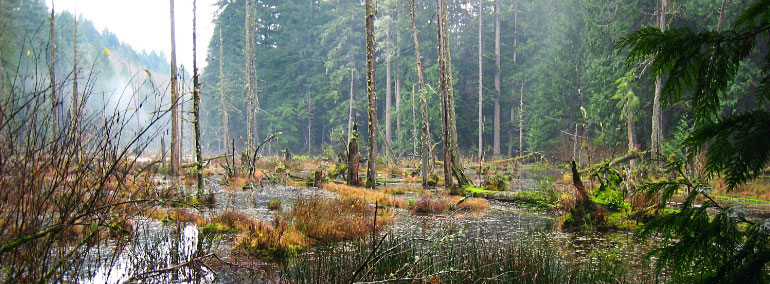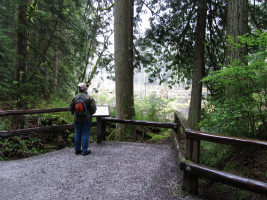Lake Louise Natural Resources Conservation Area

Features Protected: Located near Bellingham, this 138-acre site has exceptional biological diversity, ranging from bogs and wetlands—including a large and very active beaver pond—to hardwood thickets and mixed conifer forests of Douglas-fir, western redcedar and western hemlock, some with old growth characteristics. Most conifer stands on the site originated around 1840. A few remnant large Douglas-fir trees are hundreds of years old. These trees, along with charcoaled snags and stumps scattered within the area, offer clues about the cultural and fire history in the area.
Some older trees and dead snags are inhabited by birds such as pileated woodpecker, hairy woodpecker, and brown creeper—which use cavities and decaying tree trunks for nesting. In the forested areas other wildlife can be seen—black-tailed deer, Douglas squirrel, mountain beaver, and a variety of birds, including varied thrush, golden-crowned kinglet, red crossbill, and red-breasted nuthatch.
The beaver pond, formed decades ago by the damming of Beaver Creek, supports a wetland of floating and emergent vegetation including yellow pond lily, duckweed, cattails, skunk cabbage, sedges, and rushes. The pond is used by a number of bird species. Red-breasted sapsuckers and hairy woodpeckers use the pond's snags for foraging. Wood ducks and hooded mergansers potentially can use the snags for breeding cavities. Emerging insects from the beaver pond provide food for violet-green swallows and barn swallows. Other species associated with the pond include osprey, belted kingfisher, and Virginia rail.
More than 300 species of fungi and slime molds have been identified by Fred Rhoades, a retired Western Washington University faculty member.
Ecoregion: Puget Trough (Whatcom County)
Science, Research and Monitoring
Public and private universities, other research institutions and individual researchers may contact DNR to propose a research project at the site. If you are interested in pursuing research at Lake Louise NRCA, please contact David Wilderman, Natural Areas Program statewide ecologist, at david.wilderman@dnr.wa.gov.
Examples of research and monitoring projects
- Birds of Lake Louise NRCA (162KB PDF)
- Vascular plants of Lake Louise NRCA (577KB PDF)
- Beaver Creek Vegetation - Diane Kossen Doss thesis (3.6MB PDF)
Environmental Education and Public Access
Lake Louise NRCA offers excellent opportunities for environmental education and low-impact recreation. Adjacent to Lake Louise NRCA is the 248-acre Stimpson Family Nature Reserve that includes ownership by Whatcom County, Whatcom Land Trust and the City of Bellingham. Between the two, the area offers more than 4 miles of hiking trails and a number of interpretive signs to enhance the experience.
- No pets allowed.
- Garbage service is not provided. Pack out what you pack in.
- Day use only.
 Directions to Lake Louise NRCA and the Stimpson Family Nature Reserve
Directions to Lake Louise NRCA and the Stimpson Family Nature Reserve
From Bellingham, head east for 3.4 miles on Lakeway Drive. Turn right onto Lake Louise Road and continue 1.6 miles to the parking lot on your left.

